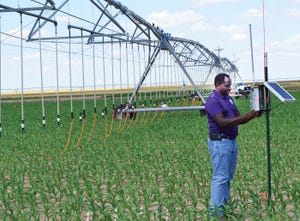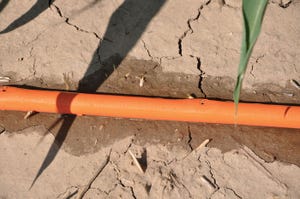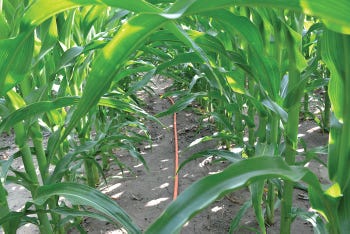
Subsurface drip irrigation (SDI) is arguably the most efficient means available for watering crops, and also also offers producers the ability to apply water in small increments without losing moisture to leaching or evaporation.

Isaya Kisekka works with a mobile drip irrigation system at the Southwest Research and Extension Center in Garden City, Kansas.
The main constraint to more widespread use has been the cost of installation and terrain limitations.
A hybrid irrigation system — a cross between subsurface drip and low energy precision application (LEPA) — could be the next step toward a more efficient irrigation system that conserves an increasingly limited water source, says Isaya Kisekka, Kansas State University assistant professor, water management, who discussed the system at the second annual Oklahoma Irrigation Conference.
An important goal of his research at the Southwest Research and Extension Center in Garden City, Kansas, he says, is to find ways to extend the usable life of the Ogallala aquifer. “Under limited water objectives, we hope to maximize water productivity and economic net returns.”
To accomplish those goals, he says, irrigation systems must reduce evaporation losses and non-uniform water distribution. Current irrigation technology has made improvements over older systems, Kisekka says, but with water resources becoming more vulnerable, agriculture needs to find even better ways to distribute water to cropland.
More efficient systems
Three systems in particular have proven more efficient than the older overhead impact center pivot irrigation that featured spray nozzles attached to the pivot arm, some 20 feet or more above the crop canopy. Evaporation loss for these systems is significant.

Drip hoses apply small amounts of water to the soil in a uniform manner across the field. — Photos: Kansas State University
Medium elevation spray application (MESA) is an improvement; it has spray nozzles attached to hoses that hang 5 feet to 8 feet above the crop. Low elevation spray application (LESA) places hoses even lower, just 1 foot to 2 feet above the crop. Low energy precision application (LEPA) systems apply water directly to the soil, often with socks on the ends to prevent pooling and possible evaporation.
Subsurface drip irrigation is an underground system that applies water in small amounts through plastic pipe buried some 12 inches below the soil surface. Water seeps from tiny holes in the pipe.
For the latest on southwest agriculture, please check out Southwest Farm Press Daily and receive the latest news right to your inbox.
A hybrid of SDI and LEPA may prove to be equally efficient, Kisekka says. “With MESA and LESA, we can see evaporation and non-uniform distribution,” he said. “We may also see some runoff. In Texas, producers use LEPA with either bubblers or drag hoses, and it is efficient with little moisture loss. But less than 1 percent of producers in Kansas have adopted LEPA.”
With LEPA, he says, producers plant in a circle so the hoses can follow the rows across and around the fields.
Mobile Drip Irrigation
The hybrid system, which he calls mobile drip irrigation (MDI), uses long pipes — similar to those in SDI systems — which are attached to and hang from the center pivot arm. These hoses lay out behind the system and apply water as they move across the field.
“We have no need for drip lines to be buried across the entire field,” Kisekka says. “We maintain the center pivot unit, but just add drip to the arm. Field elevation is not a problem, he says. “Regardless of elevation, we get the same flow rate. We can also alternate between drip and spray and can provide efficient irrigation.” Hose spacing of 60 inches works well, he says.

Hoses from a mobile drip irrigation system drag through corn rows in a KSU research plot.
Potential benefits of MDI include:
The ability to alternate between center pivot and drip as needed.
Low cost.
Rows have equal access to moisture.
Eliminates water loss.
Fertigation.
Installers should employ GPS coordinates to put in the system, he says, in order to insure uniformity and to insure that plants in each row have equal access to moisture. He is measuring soil water uniformity and evaporation levels. “MDI will provide the most benefits with limited water resources,” he says.
Droplet or canopy evaporation is not likely with either LEPA or MDI but is with other systems.
Kisekka says research shows MDI offers producers potential to improve irrigation efficiency at a price estimated to be lower than installing subsurface drip systems. “The true test will come from yield data,” he says.
About the Author(s)
You May Also Like






